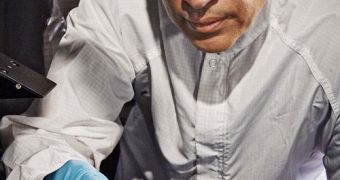Investigators at the NASA Goddard Space Flight Center (GSFC), in Greenbelt, Maryland, are currently working hard on developing a material that is blacker than pitch, in a bid to forward investigations capabilities for detecting unseen cosmic objects.
One of the primary motives driving the new work is the need to collect scientific measurements that are now extremely hard to obtain, such as those of Earth-class exoplanets orbiting distant stars.
The GSFC research team is composed of 10 exquisite technologists, who are working on creating a type of nanomaterial capable of suppressing errant light that usually contaminates readings.
Photons, the basic elementary particles making up light, have a funny way of bouncing off the surface of scientific measurement instruments, a phenomenon that leads to imprecise measurements under a large variety of conditions.
According to experts at the GSFC, this issue can be circumvented by using thin coating of multi-walled carbon nanotubes (MWCNT) on a surface. These tubes are so small that they are up to 10,000 times thinner than a human hair.
“This is a technology that offers a lot of payback. It’s about 10 times better than black paint” typically used by NASA for canceling the effects of stray light, explains engineer Leroy Sparr.
He is in charge of efforts to measure the effectiveness of the new material. His group is sporting the new coating on the next-generation marine photosynthesis instrument, called Ocean Radiometer for Carbon Assessment (ORCA).
Underlying the capabilities of the MWCNT are their super-absorption abilities. Because the nanotubes are packed extremely tight together, they absorb a whooping 99.5 percent of all light that falls on their surface.
Given that so few photons can bounce off it, measurements will no longer get contaminated. The amount of stray light reflected back into the measuring devices will simply be too small.
The GSFC team began the effort in 2007. In 2008, the Rensselaer Polytechnic Institute (RPI) announced that it had been working on a similar technology for some time, and showcased the darkest carbon nanotube-based material ever made.
“Our material isn’t quite as dark as theirs. But what we’re developing is 10 times blacker than current NASA paints that suppress system stray light,” says the leader of the GSFC development team, John Hagopian.
“Furthermore, it will be robust for space applications,” adds the expert, who is also the principal investigator for the research efforts, Space Fellowship reports.
“That’s the real strength of this effort. The group is finding ways to apply new technology and fly it on our instruments,” concludes the GSFC Instrument Systems and Technology Division assistant chief of technology Carl Stahle.

 14 DAY TRIAL //
14 DAY TRIAL //